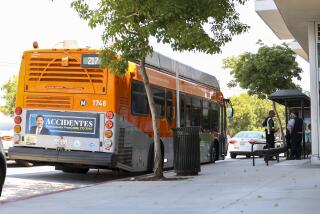CHINATOWN : Study Backs Merits of Light-Rail Station
A light-rail station linking key sites in Chinatown could be the most workable method to revive the deteriorating landmark community that over the years has lost clientele to the San Gabriel Valley, according to a study.
The 57-page report, commissioned last summer by a group of local business professionals, considers the Metropolitan Transportation Authority’s proposed Pasadena Blue Line station at Alameda and College streets as a steppingstone toward an improved Chinatown.
“The idea is to use the station as a focal point,” said William Tan, president of the Chinatown Economic Development Council. “We can look at it sort of as half of a sun that radiates out to other locations.”
Those sites, or “anchors,” could be connected to the station via walkways or bridges. The locations include vacant lots in the 800 block of North Hill Street and the northeast corner of Sunset Boulevard and Broadway, and property at Broadway and College Street--all of which could make up a “clearly defined cultural and dining district,” the study said.
It also recommends incorporating the MTA station into a master plan and forming a Chinatown revitalization and development strategy for the community of 13,800 residents, 74.8% of whom are Chinese, according to the 1990 Census.
Because it’s only a preliminary assessment, the report--based on interviews with 15 Chinatown civic and business leaders and residents--does not cover specific costs or details of what a cultural and dining district would look like.
It also does not include views from other ethnic minority groups, such as the Vietnamese and Latinos in and around Chinatown.
Tan said his group did not have the funds for more thorough research. It was granted $5,000 from Kaiser Permanente health care to hire Leadership Education for Asian Pacifics Inc. for the study.
“This is a discussion piece, not so much as a solution,” Tan said.
Chinatown has been searching for ways to rid the negative perception of the community as a crowded and unsafe area with high land prices, dirty streets and few parking spaces.
“Increased language skills, availability of land at affordable prices, good schools and changing values acted as ‘pull factors,’ attracting Chinese families out of the urban core and into communities in the San Gabriel Valley,” the report said.
David Wayne Louie, vice president of the Chinatown Economic Development Council, criticized the Community Redevelopment Agency for failing to establish a vision for Chinatown when 330 acres were tabbed redevelopment property in 1980.
“How can you plan a community, how can you talk about putting in a light-rail station without a (master plan)?” Louie said. “The exodus of people from the community, it’s also a reflection of a lack of planning.”
Redevelopment agency officials said no master plan was created because the agency followed a general city planning strategy that focused on zoning, land use and improvement of public buildings.
Since January, however, the agency has been working on a five-year plan for Chinatown, which is scheduled to be completed by September, said Don Spivack, the agency’s director of operations.
“From our perspective, we have accomplished a great deal, particularly in the area of upgrading and expanding housing development,” Spivack said.
Over the last two years, the agency has spent $1.2 million in street repairs and tree plantings, and another $10,500 for 100 bilingual street signs, redevelopment agency officials said.
More to Read
Sign up for Essential California
The most important California stories and recommendations in your inbox every morning.
You may occasionally receive promotional content from the Los Angeles Times.










